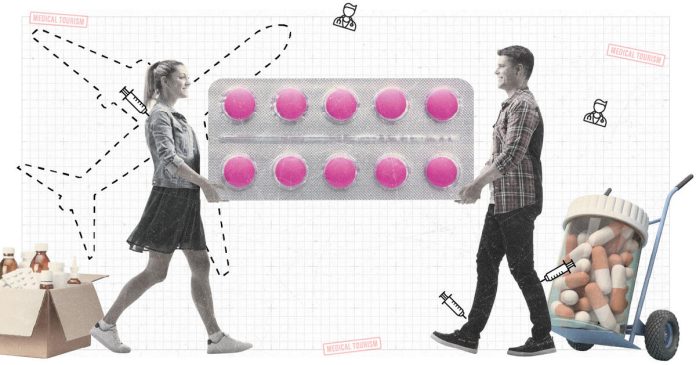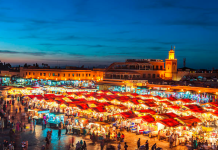US-Mexico cross-border medication trips
The notoriously high prices charged by ‘big pharma’ in the US have created a seemingly insatiable demand from Americans willing to cross the border to Mexican cities and resorts to buy medications that are available only on prescription in the US. Tramadol, a potent opioid analgesic, costs around 500 Mexican pesos (around US$27) for 60 100mg tablets – approximately the same as in the US but without the high costs of a US prescription, and available to those without health insurance.
The stock in trade at such outlets is typically extensive, ranging from opioid analgesics such as Tramadol to antidepressants like Prozac, Zoloft (sertraline) and the benzodiazepines Valium (diazepam) and Xanax (alprazolam), and erection aids like Viagra, antihistamines Triludan (terfenadine) and Atarax (hydroxizine).
Some of these, including Tramadol, Triludan and Atarax, are freely available over the counter. Others (including Valium and Xanax) require a prescription. But such prescriptions are easy to get. Many pharmacies have an in-house doctor’s office specifically to provide the paperwork after a cursory consultation.
One reason Mexico has so many pharmacies is that, although Mexico has universal healthcare, many Mexicans find it quicker and easier to source their prescription drugs from a local pharmacy.
Mexico has, historically, attracted people travelling specifically to buy painkillers or tranquillisers that aren’t readily available in the UK or the US
Being ‘so far from God and so close to the US’, as the saying goes, Mexico may be a special case. There, ‘pharma tourism’ is big business. Prescribing and providing many medicines is more easy going than in the US, the UK or European Union (EU) countries, but the sector is increasingly highly professionalised.
In 2019, the US state of Utah introduced an Rx Tourism programme that subsidises state employees covered by its insurance plan to visit Mexico to collect their prescription medicines, saving up to 60 per cent compared with the price of the same medication in the US. And at San Ysidro, the busiest border crossing between Mexico and the US, a ‘medical tourism lane’ has been created to accelerate re-entry to the US for such travellers.
But what are the risks? Aside from the potential abuse of a range of opioids and tranquillisers of lax prescribing by compliant doctors and clinics, some travellers may be tempted to self-medicate while abroad with powerful analgesics that they do not normally use at home, reassured that because such medications are available over the counter, they are risk free.
Even seemingly harmless medications such as some powerful antihistamines have attendant risks. Triludan, for example, is no longer approved in the US, UK and Canada because it can cause cardiac arrhythmia. Atarax, sometimes recommended for motion sickness as well as to counter allergy-related itching, is not a major overdose risk, but causes extreme drowsiness, especially if mixed with alcohol. Because of potential for more severe side effects, this drug is on the list to avoid in the elderly.
Counterfeit medication risk
More concerning, perhaps, is the growing issue of counterfeit medicines. Aside from a less-than-rigorous approach to prescribing, many countries on the mass tourism map in the Americas, Asia and Africa also have an issue with counterfeit medications, or indeed with the sale of medicines that have been improperly stored or are past their use-by date.
Without naming names, the US Centers for Disease Control and Prevention (CDC) warns: “Some countries’ requirements for maintaining licensure, credentialing, and accreditation may also be less than what would be required in the US. In some countries, counterfeit medicines and lower quality medical devices may be used.”
China and India, in particular, are notorious for pharmaceutical bootlegging. Counterfeit Valium made in China has been blamed for numerous deaths worldwide, including in the UK, and is widely sold and abused for recreational use in Thailand and other Southeast Asian countries. In Mexico, drug cartels import counterfeit fentanyl – an extremely potent opioid analgesic– which is then pressed into pills, packaged and passed off as oxycodone.
Most of these fake painkillers are destined to be smuggled into the US, where a record 107,600 people died of drug overdoses in 2021, the CDC reported in May 2022.
Significant quantities, though, leak into the local community, where they may be passed off by unscrupulous pharmacies as legitimate medications, or sold on the street for recreational abuse.
A burgeoning pharmaceutical manufacturing sector has made India the world’s biggest producer of affordable generic medicines, but it also has a thriving black market in bootleg pharmaceuticals.
“The country’s pharmaceutical market is the world’s third largest in terms of volume, but the thirteenth largest in value. However, counterfeiting is pervasive, with an estimated 20 per cent ($4.3 billion in 2013-2014) of India’s drug market comprised of counterfeit drugs,” according to the global consultancy company Deloitte.
The CDC concurred, stating: “Counterfeit medicine and health products are sold worldwide but are more commonly found in low and middle-income countries where it is may be hard to enforce drug quality standards. Studies show about nine to 41 per cent of medicines sold in low- and middle-income countries are counterfeit.”
The agency also warned that counterfeit drugs are hard to identify: “The only real way to know if a drug is counterfeit is through chemical analysis done in a laboratory. Sometimes, counterfeit drugs differ in size, shape, or color, or are sold in poor-quality packaging, but they often appear identical to the real thing.”
Risk to travellers
Could government departments like the UK Foreign and Commonwealth Office (FCDO) do more to alert travellers to the risks?
On its Smartraveller site, the Australian Department of Foreign Affairs and Trade focuses on the possible legal repercussions of buying medication over the counter, even from a seemingly respectable pharmacy.
“Travellers have been arrested for carrying medicine they bought at a Thai pharmacy without a prescription. Get medical advice before buying medicine,” Smartraveller advised.
In its boilerplate travel advice for several destinations including Thailand, the US State Department warned: “Exercise caution when purchasing medication overseas. Pharmaceuticals, both over the counter and requiring prescription in the United States, are often readily available for purchase with little controls. Counterfeit medication is common and may prove to be ineffective, the wrong strength, or contain dangerous ingredients. Medication should be purchased in consultation with a medical professional and from reputable establishments.”
But how are travellers to tell ‘reputable’ from ‘disreputable’ pharmacies?
“Only buy medicines from licensed pharmacies and ask for a receipt. Do not buy medicines from open markets,” advised the CDC.
Assistance companies may have a more practical part to play here. According to Federico Tarling, Chief Service Officer at Assist Card: “In order for our clients to be covered, they must only use medications prescribed by one of our contracted physicians, so that if they were to use medications prescribed by any other physician – for example, at an in-house doctor’s office within a Mexican pharmacy – they would not be covered.”
“That said, I do not recall any medical claims in the past where we were asked to cover a patient who fell ill due to any medication consumption,” he added.
“Medications which are only available on prescription in the UK … are readily available in popular nightlife districts across Thailand,” says the FCDO. “Medication sold on the street may not be genuine and/or may have been stolen. Taking medication without medical advice or a prescription can have serious health consequences.”
Pills for thrills?
What of travellers who purchase opioid painkillers or benzodiazepines either to self-medicate, for example for pain, anxiety, or for recreational purposes? Many pharmacies in Mexico reap the benefits of a well-heeled ‘gringo’ market looking for legitimate prescription medication to take home.
In developing countries less blessed (or cursed) by proximity to the US, supplying the self-medication needs of local communities is the business model for small, poorly regulated pharmacies – and for the ‘informal market’.
That in turn can create a ‘no questions asked’ culture that can be accessed quite easily by travellers too. A trawl through even the less murky shallows of the Web reveals users swapping tips on the availability of an array of quasi-legal highs.
some travellers may be tempted to self-medicate while abroad with powerful analgesics that they do not normally use
Countries where medications such as amphetamines (sometimes marketed as ‘diet pills’) and a range of sedatives have historically attracted a trickle of recreational drug users. Since the 1970s, when US President Richard Nixon declared his war on drugs, and created the Drug Enforcement Agency (DEA) to prosecute it. most countries have acted to prohibit or control sale of such drugs – although not always very successfully.
In an era where the trade in counterfeit drugs is booming, many governments seem to be fighting a losing battle.
Drug dosages vary dangerously, according to the United Nations Office on Drugs and Crime (UNODC) 2018 World Drug Report. For example, more than 70 per cent of declared shipments of tramadol to some countries exceeded their declared approved medical dosages of 50mg to 100mg by as a minimum of 20mg, to as much as 150mg. The risks of overdose are obvious.
The trade in bootleg medicines in developing countries is driven largely by dysfunctional formal health systems, according to the UNODC. “Disparities in access to essential controlled medicines around the world continue to deny relief to patients in severe pain. In 2019, four standard doses of controlled pain medication were available every day per every one million inhabitants in West and Central Africa, in comparison to 32,000 doses in North America,” the organisation states.
How much of a problem is counterfeit medication for travellers?
So, is self-medication with possibly counterfeit pharmaceuticals a potential problem for assistance companies and travel insurers? Not if providers recognise the risk and take steps to avoid it, primarily by raising traveller awareness, says Julie Remmington, director, Real Travel Assistance, a UK-based international assistance company.
“We are in a lucky position with our customers that we know generally where they are travelling to and have produced pre-travel advice emails that we send, which give the traveller information on the standard of medical care in the country they are visiting or working in,” said Remmington.
In order for our clients to be covered, they must only use medications prescribed by one of our contracted physicians
“We advise on what medication they cannot take into the country and how to navigate the health system. Most of our clients have in-country bases where they will be able to dispense medication such as painkillers to workers to keep them from needing to look elsewhere. This is not unique to us, as most medical assistance companies will do this and many will offer their traveller an app that helps them,” she added.
Some travellers may be tempted to self medicate, she acknowledges. In such instances, Real Travel Assistance urges its clients to contact the company for advice before doing so, stating: “We encourage people to call us no matter how trivial, and offer this service to the insurers as a flat monthly fee to try and keep claims costs as low as possible. If we charged a normal assistance fee for each person that called, this would not be financially viable for the insurer and therefore could leave more people vulnerable.”
Technology to the rescue?
In Africa, innovators such as the Ghanaian company mPedigree, the Nigerian health tech platform Medsaf, RxAll and True-Spec Africa have pioneered scanners and algorithms that help pharmacies quickly identify fake medicines that have been convincingly packaged as the real thing. Their effectiveness obviously depends on how willing pharmacies are to use them, but by removing an excuse for trading in counterfeit medications may be very useful for assistance companies too.
These and other solutions are essential if the flood of counterfeit medications – not just synthetic opioids, but antibiotics and antivirals too – is to be stemmed. This is a tide that will not turn on its own.
Publishing Details
Assistance & Repatriation
29 Jul 2022
Share
The Editorial Team updates the ITIJ website daily, and works on features for the print edition. With expert industry knowledge and years of experience in writing about complex travel insurance issues, the Editorial Team is ready to investigate and report on the topics that matter most to ITIJ’s readers.













